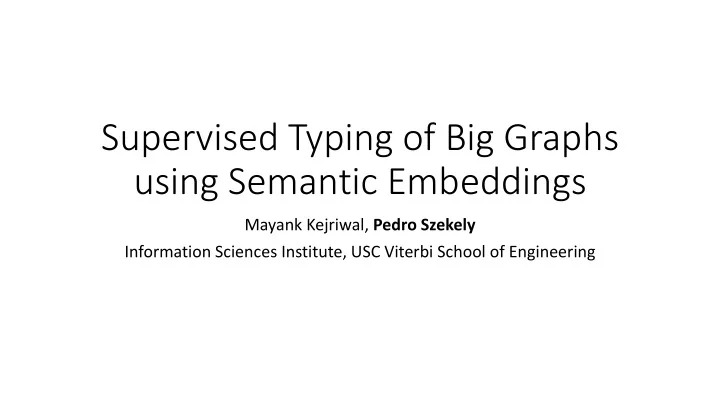

Supervised Typing of Big Graphs using Semantic Embeddings Mayank Kejriwal, Pedro Szekely Information Sciences Institute, USC Viterbi School of Engineering
Big Graphs have become ubiquitous in the Semantic Web
Typing Big Graphs • DBpedia has over 89,000 entities typed as owl:thing • Hundreds of types in the DBpedia ontology have no extensional instances • Is typing always absolute ? • Should typeOf(Arnold Schwarzenegger, Politician) be considered as likely as typeOf(Barack Obama, Politician) ?
From types to instances to back again... • Traditional view is that ontology comes first, then data • Many instances now do not conform ‘closely’ to a specified ontology • Automatic typing of instances can require a lot of feature engineering
Motivation 1: Automatic, probabilistic typing • Classify each instance as a type (multi-class classification); use classifier scores as probability • What features should be used? • What if the ontology changes (e.g., from DBpedia to Freebase)? • Clustering • How should the space be defined? • How should the probability be defined?
Motivation 2: No feature engineering • Use the data itself, not pre-defined graph patterns or features, to deduce types
Potential Data-driven Applications • Fuzzy reasoning • What is the probability of an entity being a politician, given that they are also actors? • Type Recommendation • Profiling ontology coherence • How closely does the data conform to the declaratives?
Approach • Embed instances in knowledge graph in vector space • Used existing algorithm (RDF2Vec)
RDF2Vec: Some visualizations • Based on DeepWalk algorithm • Results are fairly intuitive
Approach: intuition • Construct type embeddings in the same vector space as pre- computed entity embeddings
Algorithm
Properties of Algorithm • Only requires two passes through data, very fast! • Because of incremental nature, can work with dynamic data • Agnostic to entity embeddings, can work with any set of entity embeddings • RDF2Vec, TransE, TransH, NTN...
Target ontology vs. original ontology • Target ontology can be different from source ontology (as long as some training data is available); ontology mapping not required
Experiments • Partitioned DBpedia knowledge graph into five sets
Task 1: Type Prediction • 4 sets used for training, 1 for testing • Used kNN with voting as baseline • Found all-or-nothing phenomenon with kNN, not robust!
Task 2: Type Recommendation • Possible because we get a scored list of types with embedding method
Task 3: Ontology Coherence
Extensions: Generative Type Model (GTM)
Future Work: Instances as probability vectors • Cast each instance in DBpedia as a probability distribution over ~400+ types • Full dataset is about 100 GB uncompressed, serialized in JSON lines • Currently exploring use in large-scale ontology coherence, fuzzy reasoning at scale
Conclusion • Types, properties (more generally, ontologies) and entities are both important for realizing the Semantic Web vision • Many ontologies and datasets currently exist on the Semantic Web • Many overlap in terms of domains, many assertions possible • We showed a simple method to generate type embeddings at scale without re-running a knowledge graph embedding http://usc-isi-i2.github.io/home/ {kejriwal, pszekely}@isi.edu
Recommend
More recommend